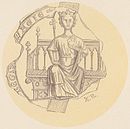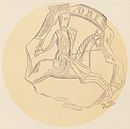Magnus VI
| Magnus the Law-mender | |||||
|---|---|---|---|---|---|
 | |||||
| King of Norway | |||||
| Reign | 16 December 1263 – 9 May 1280 | ||||
| Coronation | 14 September 1261,Bergen | ||||
| Predecessor | Haakon IV | ||||
| Successor | Eric II | ||||
| Born | 1 May 1238 Tønsberg,Norway | ||||
| Died | 9 May 1280 (aged 42) Bergen,Norway | ||||
| Burial | |||||
| Spouse | |||||
| Issue | Eric II Haakon V | ||||
| |||||
| House | Sverre | ||||
| Father | Haakon IV of Norway | ||||
| Mother | Margrete Skulesdatter | ||||
Magnus Haakonsson(Old Norse:Magnús Hákonarson,Modern Norwegian:Magnus Håkonsson;1 (or 3)[3]May 1238 – 9 May 1280) wasKing of Norway(asMagnus VI) from 1263 to 1280 (junior king from 1257).[1]One of his greatest achievements was the modernisation and nationalisation of the Norwegian law-code, after which he is known asMagnus the Law-mender(Old Norse:Magnús lagabœtir,Modern Norwegian:Magnus Lagabøte). He was the first Norwegian monarch known to have used anordinal number,although originally counting himself as "IV".
Early life[edit]
He was the youngest son of KingHåkon Håkonssonand his wifeMargaret Skulesdatter.He was born inTunsbergand was baptised in May 1238. He spent most of his upbringing inBergen.In 1257 his older brotherHåkondied, leaving Magnus the heir-apparent to the kingdom. His father gave him the title of king the same year. On 11 September 1261, he marriedIngeborg,the daughter of KingEric IV of Denmark,after she was practically abducted by King Håkon's men from the monastery she was living in. The struggle to claim Ingeborg's inheritance from her murdered father later involved Norway in intermittent conflicts withDenmarkfor decades to come. Magnus and Ingeborg were crowned directly after their marriage, and Magnus was givenRyfylkefor his personal upkeep. On 16 December 1263 King Håkon died while fighting theScottishking over theHebrides,and Magnus became the ruler of Norway.
Reign[edit]
Foreign policy[edit]
Magnus' rule brought about a change from the somewhat aggressive foreign policy of his father. In 1266 he gave up the Hebrides and theIsle of Manto Scotland, in return for a large sum of silver and a yearly payment, under theTreaty of Perth,by which the Scots at the same time recognised Norwegian rule overShetlandand theOrkney Islands.[4]In 1269 theTreaty of Winchestercemented good relations with the English kingHenry III.[5]Magnus also seems to have had good relations with the Swedish KingValdemar Birgersson,and in the 1260s, the border withSwedenwas officially defined for the first time. When Valdemar was deposed by his two brothers and fled to Norway in 1275, this stirred Magnus into gathering aleidang-fleet for the first and only time in his reign. With a large fleet, he met with the new Swedish KingMagnus Ladulåsto try to bring about a settlement between the two brothers, but without success, Magnus of Sweden would not give in to pressure and the Magnus of Norway retreated without engaging in hostile actions.
Internal policies[edit]

In internal politics, Magnus carried out a great effort to modernise the law-code, which gave him his epithetlaw-mender.These were adopted at theThingsin the years 1274 (Landslov) and 1276 (Byloven). In 1274 he promulgated the new national law, known asMagnus Lagabøtes landslov,a unified code of laws to apply for the whole country, including theFaroe IslandsandShetland.This replaced the different regional laws which had existed before. It was supplemented by a new municipal law (a law for the cities) in 1276,Magnus Lagabøtes bylov,and a slightly modified version was also drawn up forIceland.A unified code of laws for a whole country was at this time something quite new, which had until then only been introduced inSicilyandCastile.His code introduced the concept that crime is an offense against the state rather than against the individual and thus narrowed the possibilities of personal vengeance. It increased the formal power of the king, making the throne the source of justice. The municipal law gave the cities increased freedom from rural control. A specific section fixed the law of succession to the throne, in accordance with the arrangements laid down by King Håkon Håkonsson in 1260.[6]

The royal succession was an important and prickly matter, the last of the civil wars, fought for decades over disputed successions to the throne, having finally ended only in 1240. In 1273 Magnus gave his eldest son, five-year-oldEric,the title of king, and his younger brotherHåkonthe title ofduke,thus making it unequivocally clear who would be his heir.
Although Magnus was by all accounts a personally very pious king, his work with the law-codes brought him into conflict with the archbishop, who resisted temporal authority over the church, and sought to preserve the church's influence over the kingdom. The Tønsberg Concord (Sættargjerden in Tønsberg) signed in 1277 between King Magnus andJon Raude,Archbishop of Nidaros,confirmed certain privileges of the clergy, the freedom of episcopal elections and similar matters. The church preserved considerable independence in judicial matters, but gave up its old claim that the Norwegian kingdom was afiefunder the ultimate authority of the Catholic Church.[7]
In cultural terms Magnus continued his father's policy of introducing European courtly culture to Norway. In 1277 he replaced the old Norse titleslendmannandskutilsveinwith the European titlesbaronandridder(knight), at the same time giving them certain extra privileges and the right to be addressed aslord(herre). Magnus is probably also the first Norwegian king to have named himself using anordinal number- he called himself "Magnus IV" (he did not countMagnus Haraldsson(II) andMagnus Sigurdsson(IV)).[8]Immediately after his father's death, he commissioned the IcelanderSturla Þórðarsonto write his father'ssaga,or biography. In 1278, he commissioned the same man to write his own saga. TheSaga of Magnus the lawmender(Magnúss saga lagabœtis) thus became the last of the medieval Norwegiankings' sagas;unfortunately only a short fragment of it has been preserved.
Death and aftermath[edit]
In the spring of 1280, Magnus fell ill in Bergen. He planned to have his son Eric crowned at midsummer as co-ruler, but died on 9 May. Eric succeeded him at the age of 12. Real power fell to a circle of advisors, prominent among them Magnus' widow, Ingeborg. Magnus was remembered as a good ruler, who ruled by law rather than by the sword. The nationalist-conservative historianOscar Albert Johnsen,who headed the Institute of Medieval Texts, founded during theoccupation of Norway by the Nazis,considered Magnus a weak king for giving up the Hebrides and acquiescing to the demands of the Church.[9]Mostly considered a rather wise king, sparing the kingdom of unnecessary and unfruitful wars, while preserving stability at home and finally bringing theIcelandic Commonwealthunder Norwegian control.
Magnus was buried in the church of theFranciscanmonastery in Bergen, which has since the 16th century been theBergen Cathedral(Bergen Domkirke).
References[edit]
- ^abMagnus 6 Håkonsson Lagabøte – utdypning(Store norske leksikon)
- ^Lillehammer, Grete, et al. (1995)Museoteket ved Arkeologisk museum i Stavanger: Rogalandsfunn fra istid til middelalder,p. 108
- ^Hugh Tennent (1862).The Norwegian Invasion of Scotland in 1263: A Translation from Det Norske Folks Historie, by P. A. Munch; Communicated to the Archaeological Society of Glasgow by Hugh Tennent.Bell & Bain. p. 66.
- ^Full original text of the treaty, from Diplomatarium Norvegicum(inLatin)
- ^Full original text of the treaty, from Diplomatarium Norvegicum(inLatin)
- ^Magnus Lagabøtes landslov(Store norske leksikon)
- ^Sættargjerden i Tunsberg(Store norske leksikon)
- ^Skaare, Kolbjørn(1995).Norges mynthistorie: Bind 1.Universitetsforlaget. p. 332.
- ^e.g. Oscar Albert Johnsen,Noregsveldets undergang(Kristiania, 1924)
Other sources[edit]
- Sturla Þórðarson (1964) [1894].The Saga of Hakon and a Fragment of the Saga of Magnus with Appendices.Vol. 88.4. Translated by G.W. Dasent. London: Rerum Britannicarum Medii Ævi Scriptores.
- Knut Helle (1974).Norge blir en stat, 1130–1319.Universitetsforlaget. pp. 134–146.


